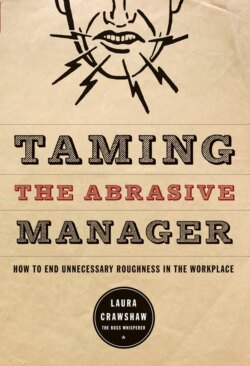Читать книгу Taming the Abrasive Manager - Laura Crawshaw - Страница 12
To Kick or Not to Kick
ОглавлениеThe suffering caused by abrasive bosses is not only injurious, it’s also inefficient. Typically, at the outset of coaching, my abrasive clients will argue this point, insisting that unless they ‘‘kick ass,’’ the work won’t get done. In his landmark article ‘‘One More Time: How Do You Motivate Employees?’’ renowned management researcher Frederick Herzberg (1968) termed this the KITA (kick-in-the-you-know-what) approach to management. However, the KITA approach presents certain drawbacks. Herzberg listed the limitations of physically kicking one’s coworkers:
(1) it is inelegant; (2) it contradicts the precious image of benevolence that most organizations cherish; and (3) since it is a physical attack, it directly stimulates the autonomic nervous system, and this often results in negative feedback—the employee may just kick you in return [p. 54].
Physical KITA and psychological KITA appear to be equally ineffective in building internal motivation:
Why is KITA not motivation? If I kick my dog (from the front or the back), he will move. And when I want him to move again, what must I do? I must kick him again. . . . But it is only when one has a generator of one’s own that we can talk about motivation. One then needs no outside stimulation. One wants to do it [p. 55].
Abrasive bosses manage for movement rather than motivation. They are blind to the fact that external intimidation does nothing to build internal motivation; they are blind to the reality that employees respond more positively to carrots than sticks. Abrasive bosses flog their coworkers into movement, whereas insightful (or what I will term adequate) bosses use positive strategies to make their employees want to move. They rely on the carrots of positive reward, unwilling to resort to psychological horsewhippings. And in the rare instances where employees refuse to move at the required pace, adequate bosses understand that beating a nearly dead horse is not only cruel—it’s also inefficient. Instead, they cut the employee from the herd through the civilized processes of formal termination. Abrasive bosses approach motivation very differently, and in the next chapters we’ll be looking at how, when, and why abrasive bosses kick their coworkers.
Speaking of motivation, you may be wondering what motivates me to coach abrasive bosses. I’m going to confess something that I never reveal to prospective corporate clients. Ready? My mission is to reduce suffering in the workplace. I dare not speak of this mission when I talk with companies struggling with an abrasive boss—it absolutely reeks of touchy-feely. I don’t want these hard-nosed business folks to suspect that they’re hiring a bleeding-heart social worker, do I? Social service types are highly suspect in the work world; we’re perceived as do-gooders intent on disrupting hard business objectives with the ‘‘soft’’ stuff of putting individual needs over organizational objectives. Woody Allen once described a nightmare in which he was pursued by a monster with the body of a crab and the head of a social worker. My body is quite human, but I spare my corporate clients the prospect of any such do-gooder nightmares by concealing my mission and instead making the case for coaching in a language they understand: facts and numbers.
